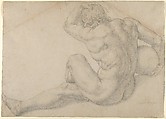Seated Male Nude (Study for the Martyrdom of St. Lawrence)
Bronzino (Agnolo di Cosimo di Mariano) Italian
Not on view
This powerful life study was preparatory for the figure of a seated River God, at lower right, in one of Bronzino’s most historically significant paintings, the very large fresco of the Martyrdom of St. Lawrence in the church of San Lorenzo, Florence. The study is an extremely rare work, since there exist only 60-65 drawings by Bronzino. The elderly artist received the commission of the Martyrdom of St. Lawrence from Duke Cosimo de' Medici in 1565, and the finished monumental fresco was unveiled in 1569. The male nude figure is shown here in a complex, seated pose that is meant to show off the artist's great mastery of drawing technique, human anatomy, and perspective. The interior modeling is achieved with seamlessly blended strokes, while the outlines maintain an impressive vigor of stroke and tonal inflection. The head and foreshortened facial features, in particular, are very boldly drawn, almost incisively so with the stick of black chalk, in order to sharpen and clarify the design for a far viewing distance. The compressed pose of the figure is precisely pinned down to align vertically the head, left shoulder, and left knee, and this creates a stark foreshortening of the limbs. In this, Bronzino's work of the 1560s constitutes a response and a challenge to the mature style of Michelangelo (who died in 1564). In turn, Bronzino's technical virtuosity as a draftsman and his superb mastery of his materials made him the greatest role model for the following generation of Florentine Mannerist artists.
(Carmen C. Bambach, 2010, revised 2014)
Due to rights restrictions, this image cannot be enlarged, viewed at full screen, or downloaded.
This artwork is meant to be viewed from right to left. Scroll left to view more.




